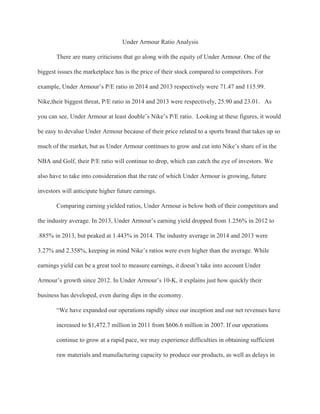More Related Content
Similar to RatioNotes (10)
RatioNotes
- 1.
Under Armour Ratio Analysis
There are many criticisms that go along with the equity of Under Armour. One of the
biggest issues the marketplace has is the price of their stock compared to competitors. For
example, Under Armour’s P/E ratio in 2014 and 2013 respectively were 71.47 and 115.99.
Nike,their biggest threat, P/E ratio in 2014 and 2013 were respectively, 25.90 and 23.01. As
you can see, Under Armour at least double’s Nike’s P/E ratio. Looking at these figures, it would
be easy to devalue Under Armour because of their price related to a sports brand that takes up so
much of the market, but as Under Armour continues to grow and cut into Nike’s share of in the
NBA and Golf, their P/E ratio will continue to drop, which can catch the eye of investors. We
also have to take into consideration that the rate of which Under Armour is growing, future
investors will anticipate higher future earnings.
Comparing earning yielded ratios, Under Armour is below both of their competitors and
the industry average. In 2013, Under Armour’s earning yield dropped from 1.256% in 2012 to
.885% in 2013, but peaked at 1.443% in 2014. The industry average in 2014 and 2013 were
3.27% and 2.358%, keeping in mind Nike’s ratios were even higher than the average. While
earnings yield can be a great tool to measure earnings, it doesn’t take into account Under
Armour’s growth since 2012. In Under Armour’s 10K, it explains just how quickly their
business has developed, even during dips in the economy.
“We have expanded our operations rapidly since our inception and our net revenues have
increased to $1,472.7 million in 2011 from $606.6 million in 2007. If our operations
continue to grow at a rapid pace, we may experience difficulties in obtaining sufficient
raw materials and manufacturing capacity to produce our products, as well as delays in
- 2.
production and shipments, as our products are subject to risks associated with overseas
sourcing and manufacturing.”(10K)
The asset turnover, which is a measurement of how well a company is using their assets
to create revenue, for Under Armour’s in 2012, 2013,2014 are as follows, respectively:
1.47,1.48,and 1.59. The industry average are as follows, respectively: 1.38, 1.32, and 1.41.
Additionally, Nike’s asset turnover are as follows: 1.50,1.44, and 1.51. As you can see, Under
Armour is investing in assets at an appropriate rate. A low asset turnover ratio can indicate issues
with management decision making, which can be from overinvesting in property or equipment
or underinvesting by leaving money sitting in the bank. While Under Armour’s profits have rose
dramatically since 2007, in 2011, they have used their profits to acquire property where their
corporate headquarters are now located, that includes land, buildings, tenant improvements, and
third party leases for $65 million. Also in 2015, Under Armour has bought the rights to both
MyFitnessPal and Endomondo, both fitness apps, in order for them to differentiate themselves
from Nike and other fitness companies that are trying to claim parts of the fitness markets.
In 2012 Under Armour’s financial leverage increased from 1.42 in 2012 to 1.50 in 2013
to 1.55 in 2014. One of the reasons the financial leverage increased from 2012 to 2013 was due
to the acquisition of MapMyFitness Inc. on December 6, 2013 for $150,000,000 in cash. This
purchase required Under Armour to take $100,000,000 in debt from the revolving credit facility
and cash on hand. Then in 2015 Under Armour purchased both Endomondo and MyFitnessPal
Inc. These purchases are estimated to $560,000,000. These acquisitions will be funded by both
the increased term loan borrowings and a draw on the increased revolving credit facility and cash
- 3.
on hand. These acquisitions explain some of the factors that affect the need for longterm debt.
Therefore, the increase in longterm debt causes Under Armour to have more financial leverage.
The financial leverage of Under Armour seems comparable to the industry average financial
leverage.
Another indicator of financial leverage is the debttoasset ratio, which is the percentage
of the firm's total assets that were financed by creditors, liabilities, and debt. Under Armour’s
2014, 2013, and 2012 debttoasset ratios are as follows: 23.549%, 33.237%, and 29.398%.
Comparatively, Nike’s debttoasset ratios are as follows: 41.788%, 36.556%, and 32.874%.
The industry average for debttoasset are as follows: 33.906%, 30.587%, and 27.445%. As you
can see, Under Armour follows the industry average pretty closely throughout the years, until
2014. According to their 2014 10K, their last substantial loan was taken in through an
acquisition in 2011, when they turned 400,000 square feet into office space, assuming $60.5
million dollars in debt. Since then, Under Armour is paying off their debt, since they have had
stable profits over the past three years. In 2015, Under Armour also acquired two fitness
programs for smart phones: MyFitnessPal and Endomondo, along with the debt. Since the 2015
statements haven’t been released, we have not seen the exact effect this will have on Under
Armour’s financials, though we are expecting their debttoasset ratio to increase closer to the
industry average. While too much debt is a risk for firms, so is having too little. [kh]

